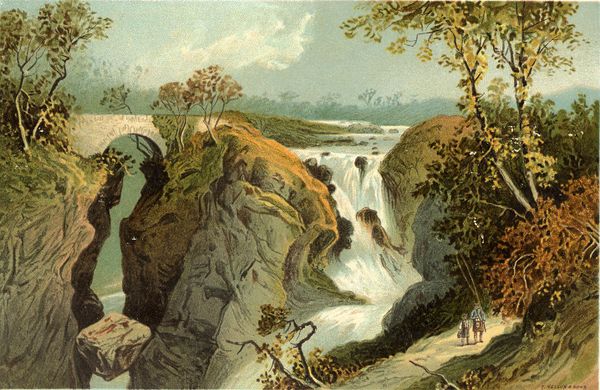Annotation:Rumbling Bridge (The): Difference between revisions
m (Text replacement - "Century Gothic" to "sans-serif") |
No edit summary |
||
| Line 7: | Line 7: | ||
---- | ---- | ||
<div style="page-break-before:always"></div> | <div style="page-break-before:always"></div> | ||
<p><font face="sans-serif" size=" | <p><font face="sans-serif" size="3"> | ||
<div style="text-align: justify; direction: ltr; margin-bottom: 90px; margin-left: 70px; margin-right: 120px;"> | <div style="text-align: justify; direction: ltr; margin-bottom: 90px; margin-left: 70px; margin-right: 120px;"> | ||
<br> | <br> | ||
'''RUMBLING BRIDGE, THE.''' Scottish, Reel (cut time). A Mixolydian. Standard tuning (fiddle). AAB. The melody appears in John and Andrew Gow’s '''A Collection of Slow Airs, Strathspeys and Reels''' (London, c. 1795). Andrew (1760-1803) and younger brother John (1764-1826) established a publishing business in London in 1788 and were the English distributors for the Gow family musical publications. The Rumbling Bridge [https://en.wikipedia.org/wiki/Rumbling_Bridge] is located above a chasm on the Bran south-west of Dunkeld in Perth and Kinross, Scotland, and was originally built in 1713 by William Gray, a mason from Saline. A nearby hamlet takes its name from the structure. The bridge spanned a narrow gorge and the rushing water of the River Devon below makes a constant sound. Later, in 1816 (long after the Gow’s publication), there was a second bridge built on top of the first one, so that it is in effect a double bridge. This wider arch gave greater width to the road and removed the steep gradients down to the old bridge. | '''RUMBLING BRIDGE, THE.''' Scottish, Reel (cut time). A Mixolydian. Standard tuning (fiddle). AAB. The melody appears in John and Andrew Gow’s '''A Collection of Slow Airs, Strathspeys and Reels''' (London, c. 1795). Andrew (1760-1803) and younger brother John (1764-1826) established a publishing business in London in 1788 and were the English distributors for the Gow family musical publications. The Rumbling Bridge [https://en.wikipedia.org/wiki/Rumbling_Bridge] is located above a chasm on the Bran south-west of Dunkeld in Perth and Kinross, Scotland, and was originally built in 1713 by William Gray, a mason from Saline. A nearby hamlet takes its name from the structure. The bridge spanned a narrow gorge and the rushing water of the River Devon below makes a constant sound. Later, in 1816 (long after the Gow’s publication), there was a second bridge built on top of the first one, so that it is in effect a double bridge. This wider arch gave greater width to the road and removed the steep gradients down to the old bridge. | ||
[[File:rumbling.jpg|600px|thumb|left|Dunkeld Cathedral and Rumbling Bridge, near Dunkeld, Perth, near the home of family scion Niel Gow.]] | [[File:rumbling.jpg|600px|thumb|left|Dunkeld Cathedral and Rumbling Bridge, near Dunkeld, Perth, near the home of family scion Niel Gow.]] The strathspey also appears under the "Rumbling Bridge" title in a small volume printed in Dublin by Edmund Lee entitled '''Mrs. Parker's Selection of Scotch Tunes, Strathspey and Reels''' (no date), which appears to be a reprint of a portion of the Gow volume.<br> | ||
<br> | |||
</div> | </div> | ||
</font></p> | </font></p> | ||
<div class="noprint"> | <div class="noprint"> | ||
== Additional notes == | == Additional notes == | ||
<p><font face="sans-serif" size=" | <p><font face="sans-serif" size="3"> | ||
<font color=red>''Source for notated version''</font>: - John & Andrew Gow’s Collection (c. 1792) [S. Johnson]. | <font color=red>''Source for notated version''</font>: - John & Andrew Gow’s Collection (c. 1792) [S. Johnson]. | ||
<br> | <br> | ||
<br> | <br> | ||
</font></p> | </font></p> | ||
<p><font face="sans-serif" size=" | <p><font face="sans-serif" size="3"> | ||
<font color=red>''Printed sources''</font> : - S. Johnson ('''A Twenty Year Anniversary Collection'''), 2003; p. 24. | <font color=red>''Printed sources''</font> : - S. Johnson ('''A Twenty Year Anniversary Collection'''), 2003; p. 24. | ||
<br> | <br> | ||
<br> | <br> | ||
</font></p> | </font></p> | ||
<p><font face="sans-serif" size=" | <p><font face="sans-serif" size="3"> | ||
<font color=red>''Recorded sources'': </font> <font color=teal> - </font> | <font color=red>''Recorded sources'': </font> <font color=teal> - </font> | ||
</font></p> | </font></p> | ||
Revision as of 20:26, 3 February 2020
X:1 T:Rumbling Bridge, The M:C| L:1/8 R:Reel B:John & Andrew Gow - A Collection of Slow Airs, Strathspeys B:and Reels (London, c. 1795) K:Amix d|eATcA c/d/e f2|eAcA BdGB|eAcA c/d/e f2|BGdB eAA:|| g|abag abeg|Bdgd BdGg|abag abeg|BGdB eAAg| abag abeg|Bgdg BdGB|eAcA c/d/e f2|dGdB eAA||
RUMBLING BRIDGE, THE. Scottish, Reel (cut time). A Mixolydian. Standard tuning (fiddle). AAB. The melody appears in John and Andrew Gow’s A Collection of Slow Airs, Strathspeys and Reels (London, c. 1795). Andrew (1760-1803) and younger brother John (1764-1826) established a publishing business in London in 1788 and were the English distributors for the Gow family musical publications. The Rumbling Bridge [1] is located above a chasm on the Bran south-west of Dunkeld in Perth and Kinross, Scotland, and was originally built in 1713 by William Gray, a mason from Saline. A nearby hamlet takes its name from the structure. The bridge spanned a narrow gorge and the rushing water of the River Devon below makes a constant sound. Later, in 1816 (long after the Gow’s publication), there was a second bridge built on top of the first one, so that it is in effect a double bridge. This wider arch gave greater width to the road and removed the steep gradients down to the old bridge.

